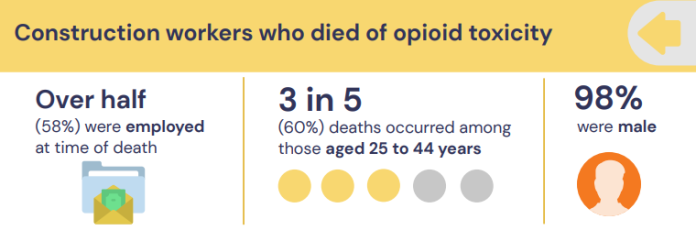By Steve Pawlett
Special to Ontario Construction News
A recently released report has found one in 13 opioid-related deaths between 2018 and 2020 occurred among Ontario construction workers.
The report reveals deaths among construction workers are primarily driven by the use of unregulated drugs – not prescribe pharmaceuticals – for pain management. Cocaine, Fentanyl, and alcohol were most involved in opioid toxicity deaths.
“The disproportionate impact of Ontario’s overdose crisis among people working in the construction industry demands further attention,” said Dr Tara Gomes, lead author of the report. Gomes is a scientist at the Li Ka Shing Knowledge Institute of St. Michael’s Hospital and ICES and a Principal Investigator of the ODPRN.
 “Despite a high prevalence of pain among workers, prescription opioids are not driving the patterns in this industry; most deaths involve a combination of opioids with other drugs and alcohol. This could reflect a reliance on non-prescription opioids to manage unresolved pain in a sector where workplace culture and lack of job security can lead to under-reporting of injuries and pressure to minimize recovery time,” explains Gomes.
“Despite a high prevalence of pain among workers, prescription opioids are not driving the patterns in this industry; most deaths involve a combination of opioids with other drugs and alcohol. This could reflect a reliance on non-prescription opioids to manage unresolved pain in a sector where workplace culture and lack of job security can lead to under-reporting of injuries and pressure to minimize recovery time,” explains Gomes.
Over the study’s 30-month span, 428 Ontarians with an employment history in the construction industry died of opioid toxicity. In contrast, people working in the construction industry represented only 3.6 per cent of the entire Ontario population and 7.2 per cent of all employed people in Ontario in 2021.
Using data from ICES and the Office of the Chief Coroner of Ontario, researchers explored the circumstances surrounding the deaths and found:
- Fentanyl and cocaine involvement were significantly higher among those with an employment history in construction. Alcohol also directly contributed to one in five opioid toxicity deaths among construction workers, which was substantially more common than among those without a history of employment in construction.
- Nearly 80 percent of opioid toxicity deaths among construction workers occurred in private residences and rarely at construction sites or motels/hotels used for work purposes.
- Among cases where an individual was present to intervene in the overdose, naloxone administration decreased slightly over time among those who died of opioid toxicity and had worked in the construction industry, suggesting the need for increased accessibility to naloxone in this population, including in people’s homes and not just on work sites.
- Only one in six construction workers with an opioid use disorder (OUD) diagnosis who died of opioid toxicity had accessed treatment the month before death, which is lower than observed among those with no history in construction.
The report also describes the demographic characteristics of people who worked in the construction industry who died of opioid toxicity:
- Nearly 60 percent of individuals in the construction industry were employed at the time of opioid toxicity death, compared to only 12 percent of those with no employment history in the construction industry.
- Pain was highly prevalent among construction workers who died of opioid toxicity – almost 80 percent experienced a pain-related condition or injury in the five years before opioid toxicity death, similar to those with no employment history in construction.
- Opioid toxicity deaths were more concentrated among those aged 25 to 44 years, with almost two-thirds of deaths among people who worked in the construction industry falling in this age group.
- Over 98 percent of construction workers who died of opioid toxicity were male, compared to 72 percent among those without a history of employment in the construction industry.
The report’s authors call for an industry-level response in the construction industry that recognizes the stigma around drug use that makes people less likely to engage in treatment and harm reduction.
The authors recommend an industry-level response that includes improving access to naloxone within homes and raising awareness about how to use drugs more safely.
“The report shows young men continue to die from preventable opioid-related deaths. Each death is a person who lost their life. Their families have lost a loved one, their communities have suffered a loss, and coworkers have lost a colleague and friend. Developing policies to address the stigma and provide support and harm reduction services at the workplace will help prevent further opioid-related deaths,” said Dr Dirk Huyer, Chief Coroner for Ontario.
Researchers led the report from the Ontario Drug Policy Research Network (ODPRN) at St. Michael’s Hospital, a site of Unity Health Toronto, ICES, the Office of the Chief Coroner for Ontario, and Public Health Ontario.
The report was funded by the Government of Ontario and the Canadian Institutes of Health Research (CIHR).

